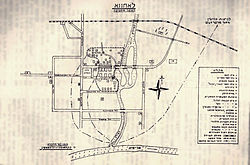Łachwa Ghetto
| Łachwa Ghetto | |
|---|---|
| Transit ghetto | |
| Łachwa location east of Brześć Ghetto and Sobibór extermination camp during World War II | |
| Coordinates | 52°13′N 27°6′E / 52.217°N 27.100°ECoordinates: 52°13′N 27°6′E / 52.217°N 27.100°E |
| Known for | The Holocaust in Poland |
Łachwa (or Lakhva) Ghetto was a World War II ghetto created on 1 April 1942 by Nazi Germany in the town of Łachwa in occupied Poland (now Lakhva, Belarus), with the aim of persecution, terror and exploitation of the local Jews. The ghetto existed only until September. It was the location of one of the first, and possibly the first,Jewish ghetto uprising after the Nazi–Soviet Invasion of Poland.
The German army entered the Soviet occupation zone on 22 June 1941 under the codename Operation Barbarossa and two weeks later, on 8 July 1941, overran the town of Łachwa, located in the Polesie Voivodeship of the Second Polish Republic before 1939. Many young Jews escaped with the Red Army. A Judenrat was established, headed by a former Zionist leader, Dov Lopatyn. Rabbi Hayyim Zalman Osherowitz was arrested by the Germans. His release was secured later only after the payment of a large ransom.
On 1 April 1942, the town's Jews were forcibly moved into a new ghetto consisting of two streets and 45 houses, and surrounded by a barbed wire fence. The ghetto housed roughly 2,350 people, which amounted to approximately 1 square metre (11 sq ft) for every resident.
The news of massacres, committed throughout the region by German Einsatzkommandos, soon spread to Łachwa. The Jewish youth organized an underground resistance under the leadership of Isaac Rochczyn (also spelled Yitzhak Rochzyn or Icchak Rokchin), the head of the local Betar group. With the assistance of Judenrat, the underground managed to stockpile axes, knives, and iron bars, although efforts to secure firearms were largely unsuccessful.
...
Wikipedia



